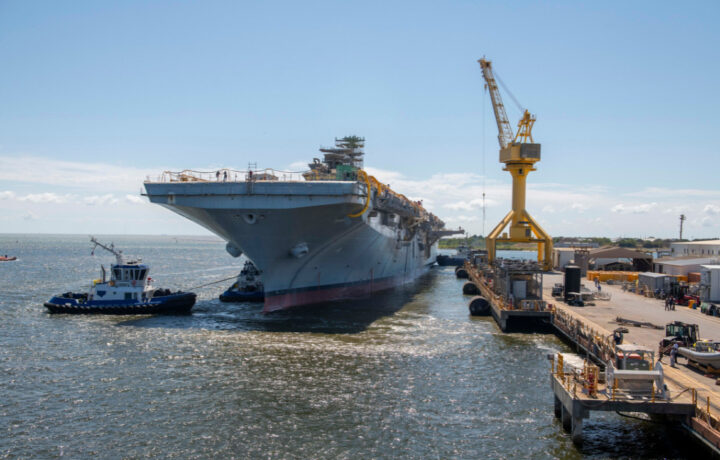The United States Navy has been “down” a flattop since the amphibious assault ship USS Bonhomme Richard (LHD-6) was seriously damaged in a fire in July 2020 and subsequently decommissioned. The vessels, which are capable of transporting almost the full strength of a United States Marine Corps Marine Expeditionary Unit (MEU) and landing them in hostile territory via landing craft or helicopters, are almost as large as the aircraft carriers in service with foreign navies.
The United States Navy has relied on these vessels as parts of its efforts to conduct maritime security operations to promote peace and stability in neutral waters around the world.
Now the U.S. Navy is one step closer to seeing the latest amphibious assault ship enter service.
Earlier this month, HII’s Ingalls Shipbuilding division announced that the future USS Bougainville (LHA-8) was successfully launched from its floating dock into the Pascagoula River.
“This launch is a significant accomplishment for our entire LHA shipbuilding team, and we are honored to be building such a versatile ship for our Navy and Marine Corps partners,” said Ingalls Shipbuilding Amphibious Ship Program Manager Gene Miller. “It is also a testament to the outstanding teamwork we see every day as our shipbuilders continue the critical work of preparing Bougainville for delivery.”
On Monday, USS Bougainville was then transfered from land to the company’s floating dry dock using translation railcars to support the ship. While in the dry dock, the Ingalls team completed final prep work for launch, the company reported.
All is Well (Deck)
The future USS Bougainville will be the first ship in the America-class to be built with a well deck, a hanger-like deck located at the waterline in the stern of the warship. It can allow vessels including landing craft, amphibious vehicles, and even recovered spacecraft crew capsules to dock within the ship.
The USS America (LHA-6) and USS Tripoli (LHA-7) were designed and built without a well deck to make space for aircraft and aviation fuel. The Flight I vessels of the class – including LHA-8 – featured a compromise, incorporating a slightly smaller aircraft hanger, as well as smaller medical and other spaces to fit a compact well deck for surface connector operations.
However, the warship still retains aviation capabilities while adding the surface assault capability of a well deck and a larger flight deck configured for F-35B Joint Strike Fighter and MV-22 Osprey aircraft. The U.S. Navy’s large-deck amphibious assault ships also include top-of-the-line medical facilities with full operating suites and triage capabilities.
The construction of the USS Bougainville has not been entirely without issue. A fire in the ship’s superstructure resulted in six minor injuries, while there was minimal damage to the ship. Despite the setback, LHA-8 is set to be commissioned by the end of next year.
Mini-Aircraft Carriers
The U.S. Navy’s America-class amphibious assault ships were designed as multi-functional and versatile vessels that are capable of operating in a high-density, multi-threat environment as an integral member of an expeditionary strike group, an amphibious task force or an amphibious ready group.
The flattops can accommodate more than 1,000 personnel and are able to travel at speeds greater than 20 knots (37 kilometers/23 miles per hour).
To date, Ingalls has delivered 15 large-deck amphibious ships to the U.S. Navy.
The shipyard delivered the first in the new America class of amphibious assault ships (LHA 6) in 2014. The second ship in the America-class, USS Tripoli (LHA 7), was delivered to the Navy in early 2020. In addition to the USS Bougainville, the future USS Fallujah (LHA 9) is currently under construction at the shipbuilder’s facility in Pascagoula, and the company authenticated the keel during a ceremony last month.




